Lisa Braxton
Lisa Braxton is the author of the novel, The Talking Drum, winner of a 2021 Independent Publisher (IPPY) Book Awards Gold Medal and winner of a 2020 Outstanding Literary Award from the National Association of Black Journalists. She is also the author of the award-winning Dancing Between the Raindrops: A Daughter’s Reflections on Love and Loss.
Tell us about your newest book.
It is 1971. The fictional city of Bellport, Massachusetts, is in decline with an urban redevelopment project on the horizon expected to transform this dying factory town into a thriving economic center. This planned transformation has a profound effect on the residents who live in Bellport as their own personal transformations take place. Sydney Stallworth steps away from her fellowship and law studies at an elite university to support husband Malachi’s dream of opening a business in the heart of the black community of his hometown, Bellport. For Omar Bassari, an immigrant from Senegal, Bellport is where he will establish his drumming career and the launching pad from which he will spread African culture across the world, while trying to hold onto his marriage. Della Tolliver has built a fragile sanctuary in Bellport for herself, boyfriend Kwamé Rodriguez, and daughter Jasmine, a troubled child prone to nightmares and outbursts. Tensions rise as the demolition date moves closer, plans for gentrification are laid out, and the pace of suspicious fires picks up. The residents find themselves at odds with a political system manipulating their lives and question the future of their relationships.
What inspired you to write The Talking Drum?
My parents are the inspiration for The Talking Drum. They opened a high-fashion men’s clothing store in 1969 in an urban area of Bridgeport, Connecticut. The neighborhood, which was thriving when they moved there from the South in the 1950s was on the decline not long after they opened the clothing store. Factories left the city, crime increased. That neighborhood is now undergoing gentrification, much like the neighborhood in The Talking Drum.
How would you describe this book to someone in a 30-second blurb?
The Talking Drum centers on three young couples in the early 1970s and how their lives are affected when an urban redevelopment project takes over an immigrant neighborhood for gentrification.
What genre do you focus on?
I focus on both fiction and nonfiction. I enjoy expressing myself in both genres and it’s a great mental exercise to be able to switch from one to the other. More specifically I enjoy writing about African Americans and social justice themes. I think there are so many stories yet to be told from the African American perspective. By writing on social justice themes I hope to inspire readers to advocate for a cause that will in some way bring about improvement in society.
Why do you write?
I am a quiet person. I grew up being overlooked often by the other kids or teased. I’m driven to write because if someone picks up an essay, short story or book I’ve written, they can’t overlook me. And I can have an impact. Also, for whatever reason, I constantly have all kinds of story ideas swirling around in my head.
Who is your main character, and how did you choose that name?
Sydney Stallworth is my main character. She is a law student who puts her studies on hold to support her husband’s desire to leave academia and open up a bookstore in his hometown. I liked the name because it seemed gender neutral to me.
What is your work schedule like when you’re writing a book?
I have no schedule. I have a full-time career as a communications manager for a nonprofit and am active in my church and charitable causes, so I write when I have snatches of time, when I’m on commuter rail to get into work, on airplanes, at the airport gate. Sometimes I’ll rise an hour early and write. Also, when I’m traveling I like to book the hotel for an extra day so I can spend that time writing.
What is the hardest part of being an author?
The hardest part for me is getting people to notice my book and embrace it. There is so much good literature out there and since I am published by a small press with a small budget, I don’t have the support of a large publishing house marketing department. I am searching for strategic and clever ways to get readers to purchase copies.
What’s the best part of your author’s life?
Knowing that my words mean something to people. That people can read my words and be impacted by them, that they can learn something from what I’ve written, that my words can assure them when they’re uncertain, or entertain them and make them laugh out loud.
Do you have other books? We’d love to know.
My memoir: Dancing Between the Raindrops: A Daughter’s Reflections on Love and Loss. In my memoir, I take the reader to the core of my loss and extend a lifeline of comfort to anyone who needs to be reminded that in their grief they are not alone.
What are you working on now?
Another novel, historical fiction taking place in Boston during the 19th century.
Website: https://lisabraxton.com/
Link to book: https://www.inanna.ca/product/the-talking-drum/
Social media links:
TwitterX: @lisareidbraxton
Twitter/X: @lisaannbraxton
Instagram: lisabraxtonwrites
Facebook: https://www.facebook.com/lisa.a.braxton/
LinkedIn: https://www.linkedin.com/in/lisabraxton/
Meet author Abbey Downey

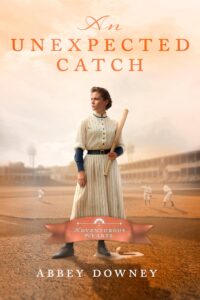 Abbey Downey started writing inspirational romance stories during naptime when her kids were babies and found she couldn’t stop. A life-long Midwestern girl, Abbey lives in central Indiana with her husband, two kids, and one rather enthusiastic beagle. She loves watching her kids play sports and fixing up a 1900 farmhouse with her husband. Connect with Abbey at abbeydowney.com.
Abbey Downey started writing inspirational romance stories during naptime when her kids were babies and found she couldn’t stop. A life-long Midwestern girl, Abbey lives in central Indiana with her husband, two kids, and one rather enthusiastic beagle. She loves watching her kids play sports and fixing up a 1900 farmhouse with her husband. Connect with Abbey at abbeydowney.com.
Tell us about your newest book.
An Unexpected Catch is set in 1907 and tells the story of Bea Curran, a female umpire in the semi-professional Chicago City Baseball League, and Emmett Worland, a pitcher who is hiding a potentially career-ending secret. Neither one is looking for love but when they begin working together to help the college women’s baseball team Bea coaches, they unexpectedly fall for each other.
What inspired you to write this book?
The whole Adventurous Hearts series was inspired by real women who were involved in the early days of sports and exploration. In almost every instance, women started joining in right alongside men, but as soon as the governing bodies realized it, females were barred from participating for decades. While I heavily fictionalize the stories for my books, I wanted to shed some light on those pioneering women. An Unexpected Catch is based on Amanda Clement, who is said to be the first female who was paid to umpire in baseball. She was also a widely accomplished athlete and spent a big part of her life training other women to teach physical education, the precursor of our gym teachers.
What genre do you focus on?
My books are historical, while my short stories are mixed between historical and contemporary. But no matter the time period, there’s always romance. I’ve loved love stories since I was very young, and I can’t imagine writing without a romantic element. I usually include overt Christian elements in my books because one of my goals for my writing is that it will encourage fellow Christians in their faith. It’s also very important to me that there are high-quality, interesting books out there for readers who want a love story without the level of explicit content that’s trending right now. For several reasons, I won’t read spicy books, and I want to help provide alternatives for other readers like me.
Why do you write?
I write largely to encourage other believers in their faith through fictional stories. When I was an advanced young reader, Christian fiction as we know it was only beginning to grow as a genre. I could read those early Christian romance novels at that age because they were guaranteed not to have anything inappropriate in them. I loved experiencing new times and places while growing in my understanding of my faith. I hope to provide readers with a similar experience!
Who is your main character, and how did you choose that name?
Bea’s first name is one that I used for a side character in a book I wrote that will probably never be published. But it inspired my Adventurous Hearts series, and I used several characters from it in the series, including Bea. Her last name is special to me because it’s the last name of some extended family from my dad’s side and I have a passion for family history.
What’s one thing your readers should know about you?
Something readers might like to know, if they haven’t already picked up on it, is that I started out writing under a pen name and had two books published with Love Inspired Historical using that name (Mollie Campbell). I HATED doing in-person events and interviews using a name that wasn’t mine, though. I just never knew how to introduce myself without going into the whole story. So when I switched publishers, I also changed to using my real name. Yes, no matter how much it might sound like I jumped on the Downton Abbey train, this is my real married name.
How have you changed or grown as a writer?
It’s an ongoing process, but my perspective on writing has changed over time from seeing publication as the goal to seeing each book I get to release as a step in the journey. I’ve experienced a decent amount of two steps forward, one step back in my writing career, even after my first book came out. Writers, being published doesn’t mean you’ve arrived! Keep learning and growing and be willing to adjust your career path expectations (because we all have to at some point).
What is your favorite pastime?
My family moved to three acres in the country a few years ago so we spend a lot of time taking care of our previously neglected property. Working together to improve our home is one of my favorite things. I also love working on embroidery and cross stitch in the evenings. And reading, of course!
Do you have other books? We’d love to know.
Be sure to check out the first book in this series, An Uncertain Road. It’s about a female racecar driver and the reluctant, grumpy mechanic who ends up riding along with her on a ten-day endurance race in 1905. The series is only loosely connected by theme so the books can be read in any order.
I also wrote two books for Love Inspired Historical under a pen name several years ago. You can find Taking on Twins and Orphan Train Sweetheart by Mollie Campbell in ebook on Amazon and Harlequin.com.
What are you working on now?
I have just finished book 3 in the Adventurous Hearts series, which will be released in July 2025. It’s set in 1910 and follows a woman who started her own version of the Explorer’s Club and is embarking on her first international expedition—while falling in love with her best friend in the process. I’m still tossing around ideas for what comes after that, but readers can be sure it will include romance, faith, and lots of interesting history!
Website: www.abbeydowney.com
Link to book: https://www.amazon.com/dp/1963212096
Social media links:
https://www.facebook.com/AbbeyDowneyAuthor
https://www.instagram.com/abbeydowney/
https://www.goodreads.com/author/show/45241091.Abbey_Downey
Faith, Hope, and Love in all my stories

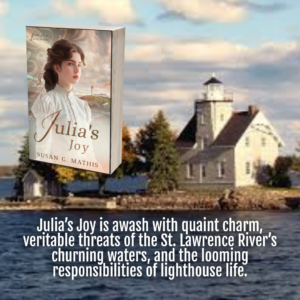 As with all of my stories, faith, hope, and love are reoccurring themes. In Julia’s Joy, the overarching message is one of hope—a theme that resonates throughout all thirteen stories in my Thousand Islands stories. This hope is multi-faceted, encompassing aspirations for a better future, the promise of love, and the transformative power of healing.
As with all of my stories, faith, hope, and love are reoccurring themes. In Julia’s Joy, the overarching message is one of hope—a theme that resonates throughout all thirteen stories in my Thousand Islands stories. This hope is multi-faceted, encompassing aspirations for a better future, the promise of love, and the transformative power of healing.
At its core, Julia’s Joy illustrates that even in the face of profound loss, there is always the possibility of a brighter tomorrow. Julia enters Sister Island burdened by her past, yet as she engages with the community and experiences the island’s beauty, she begins to envision a life filled with potential. This transformation serves as a reminder to readers that the future can be reimagined, regardless of the pain that may anchor us.
The story also explores the theme of love—both romantic and familial. Julia’s journey toward opening her heart to William symbolizes the beauty of new beginnings, even after betrayal and heartache. Their relationship blossoms amidst their individual struggles, showcasing how love can serve as a powerful catalyst for healing. This message encourages readers to believe in the possibility of love, even in the aftermath of loss.
A significant aspect of hope in Julia’s Joy is the emphasis on forgiveness. Julia’s journey includes coming to terms with my family’s betrayals and her own feelings of abandonment. By learning to forgive—not just others but also herself—she embarks on a path of healing. This theme encourages readers to confront their own grievances, suggesting that forgiveness can be a vital step toward emotional freedom and renewal.
Faith plays a pivotal role in Julia’s transformation. Throughout her struggles, she learns to embrace God’s redemption, finding solace and strength in her spiritual beliefs. This aspect of the narrative underscores the idea that, no matter how broken we may feel, there is always a way back to wholeness through faith and community. For readers, this message serves as a gentle reminder that divine love can guide us through our darkest moments.
About Julia’s Joy:
She came to claim her inheritance, but the mysterious scarred lighthouse keeper makes her question all her plans.
When Julia Collins reluctantly sets foot on Sister Island, compelled by her wealthy grandmother’s will, she is intent on claiming her inheritance and moving on. But when she experiences the peaceful, faith-filled island life, and connects with the handsome lightkeeper, William, Julia finds herself confronting her open wounds from her parents’ deaths.
William Dodge, lightkeeper of Sister Island, harbors a heart hardened by a past betrayal. Between that and his chronic pleurisy, he wants nothing to do with love. But when Julia arrives on the island bursting with vitality and unconventional notions, William’s world is turned upside down. As she chips away at the walls William has built for himself, he finds his reluctance waning.
But just as love begins to blossom between them, Julia is faced with a tempting proposal from a prominent Brockville family. Will she succumb to societal expectations or choose the richness of her island life and the love of the steadfast lightkeeper?
Buy links: Amazon | Barnes&Nobles | Wild Heart Books
Meet author Susan Pope Sloan

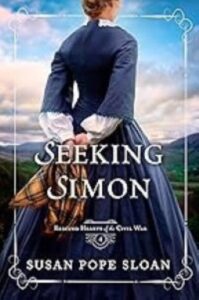 Susan Pope Sloan is a historical fiction author, book reviewer, and speaker. A retired technical writer, she combines her love of history and language in her novels. Each book in her Rescued Hearts of the Civil War series received excellent reviews in Publishers Weekly in 2023. Susan enjoys giving talks related to her books and research at local museums. Susan and husband Ricky reside in Columbus, Georgia, with access to many historic sites.
Susan Pope Sloan is a historical fiction author, book reviewer, and speaker. A retired technical writer, she combines her love of history and language in her novels. Each book in her Rescued Hearts of the Civil War series received excellent reviews in Publishers Weekly in 2023. Susan enjoys giving talks related to her books and research at local museums. Susan and husband Ricky reside in Columbus, Georgia, with access to many historic sites.
What inspired you to write Seeking Simon?
My last book, Managing Millie, mentioned that hero’s brothers, who fought on opposing sides during the Civil War. With the war ended, I thought it would be natural to see how the brothers adjusted—especially Simon, who left home under a cloud before the war started. The Reconstruction period introduced new challenges for everyone in the South.
How would you describe this book to someone in a 30-second blurb?
Illness waylays Simon, a prodigal son, on his way home after the Civil War. When the home of his host is threatened, Simon claims the man’s daughter as his fiancée to save it, creating a tangle of issues for all of them.
What genre do you focus on?
Christian historical romance embraces all the elements that appeal to me. I think we can gain so much insight from history, and romance usually promises a happy ending. As a Christian, it’s only natural to include the promises and comfort from Scripture that enrich our lives and point others to the Master.
Who is your main character, and how did you choose that name?
Character names offer insight into the person. Simon McNeil is much like the Apostle Simon Peter—impulsive and passionate. With my heroine, Daviana, her name became a sticking point because she was much more than her nickname (Dottie). As Dottie, she appeared briefly in Loving Lydia, with no indication she would later demand her own story. Many hours of searching and dithering went into choosing her formal name.
What is the hardest part of being an author?
Writing is hard, but marketing is even harder. As an introvert, I’m happy to stay behind the scenes and uncomfortable with “putting myself forward” as marketing requires.
What’s the best part of your author’s life?
The best part of being an author is meeting other authors and readers who understand the “pull” of writing and reading—living vicariously through the characters in books.
What’s one unusual fact about you?
My father was a gospel songwriter, and I traveled with my family to sing in various churches and other venues from the time I was three years old. These days, I sing periodically on the praise team at church and dress in my Victorian costume during the Christmas season to go a-caroling.
What is your favorite pastime?
Besides reading, I love singing and learning new music.
Do you have other books? We’d love to know.
My Rescued Hearts of the Civil War series includes Rescuing Rose, Loving Lycia, and Managing Millie. After Seeking Simon, there will be one more. I also self-published three small manuals on organizing a caroling group.
What are you working on now?
Book number five in this Civil War series, Redeeming Rupert, which focuses more on the aftermath of the war and Reconstruction.
Website: https://susanpsloan.com
Link to book: Amazon.com: Seeking Simon (Rescued Hearts of the Civil War Book 4) eBook : Pope Sloan, Susan : Kindle Store
Social media links: linktr.ee@susanpopesloan
Meet author Ane Mulligan

Ane Mulliga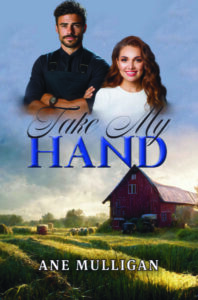 n lives life from a director’s chair—in community theatre and at her desk creating novels. Entranced with story at age three, at five she saw Peter Pan onstage and was struck with stage fever. When her passions collided, an award-winning, bestselling novelist emerged. She believes chocolate and coffee are two of the four major food groups. She lives in Sugar Hill, GA, with her artist husband and a rascally Rottweiler.
n lives life from a director’s chair—in community theatre and at her desk creating novels. Entranced with story at age three, at five she saw Peter Pan onstage and was struck with stage fever. When her passions collided, an award-winning, bestselling novelist emerged. She believes chocolate and coffee are two of the four major food groups. She lives in Sugar Hill, GA, with her artist husband and a rascally Rottweiler.
Tell us about your newest book.
Dreams and futures are at stake. Theatre transformed Marleigh Evans from a shy, timid girl into a confident young woman. Now she wants to pass that gift along to others, and dreams of owning a community theatre. After years of searching, she’s found the perfect place to see her dreams realized … and transform her community.
Circumstantial chef, Gabe Sadler, has grown irritated at his father’s business practices. Now, his dream is to own a farm-to-table restaurant and enough land for a small urban farm. After years of searching, he’s found the perfect place to see his dreams realized, and he’s not used to anyone standing in his way. Which one will win? And at what cost?
What inspired you to write Take My Hand?
I founded a community theatre and I’m its managing director. Like writing, Theatre is a passion. What better than to combine my two passions into one?
How would you describe this book to someone in a 30-second blurb?
When two people have a dream but want the same property on which to build it, someone has to lose.
What genre do you focus on?
Women’s fiction … whether contemporary or historical, all my books feature an ensemble cast of strong Southern women helping each other through the story.
Why do you write?
Karen Ball said it best a number of years ago: God whispers to my heart and my heart whispers back in stories. I’m a dreamer, and I see stories everywhere I look. The characters I envision then harp at me to share their story. If I didn’t write, I don’t know what I would do about them.
Who is your main character, and how did you choose that name?
Marleigh Evans and Gabe Sadler are my main characters. I collect names. Names are very important to me and to the character. I’ve had a few who refused to continue until I changed their name. Once I have the story idea and the main character’s personality, I find photos that match. Then I search for their names.
What is your work schedule like when you’re writing a book?
I do my best creating in the morning. I can edit anytime, anywhere, but the creation is best done in my office in my writing chair. That said, I’ve learned to write any time and any place. I’m often in the theatre working on props, sets, costumes, etc. Also, my husband, an artist, is our set designer. I accompany him when he’s working on a set, so my laptop goes with me. If I finish my tasks and he’s not done, I can write.
What is the hardest part of being an author?
Getting the first draft on paper. I’m not a big plotter. I know the beginning, some of the things that must happen to get me to the end, which I know. All the in-between is up to the characters, and sometimes, I hit a wall. Then I have to step away for a day or so, until an idea hits.
What’s the best part of your author’s life?
Talking about books with book clubs and teaching about writing books at writers conferences.
What’s one thing your readers should know about you?
I’ve always had and enjoyed close women friends, and that shows up in my books. Each has an ensemble cast of strong Southern women—sisters or friends—helping each other through the story.
How have you changed or grown as a writer?
I’m growing in the craft every day. I don’t think any writer is ever “there.” I’m working on applying more subtext in my writing in subtle ways. As writers, we must learn finesse in applying any tool from our toolbox. Whether it’s the five senses or subtext, you don’t want to beat the reader over the head. I’m consciously working on the seamlessly weaving of those tools into my work.
What is your favorite pastime?
Reading, playing in the theatre, and signing in a community choir.
Do you have other books? We’d love to know.
My first series, the Chapel Springs series, has four books in it: Chapel Springs Revival,
Chapel Springs Survival, Home to Chapel Springs, and Life in Chapel Springs.
The Georgia Magnolias series contains three books: In High Cotton, On Sugar Hill, and By the Sweet Gum. Novellas: A Magnolia Blooms in Winter, part of A Southern Season: Four Stories From A Front Porch Swing. Stand-alone novel: When the Bough Breaks.
What are you working on now?
I just finished another book set in the Great Depression. Its working title is Up Level Creek, and I’m now working on a Christmas cozy. It’s working title is The Janet Claus Caper.
Website: www.anemulligan.com
Link to book: www.amazon.com/dp/1645263320/
Social media links: Facebook, Instagram, Pinterest,
Blogs: The Write Conversation, and Blue Ridge Conference Blog
Researching Julia’s Joy

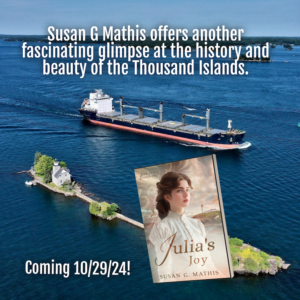 The creation of Julia’s Joy was not only a labor of love but also a meticulous research endeavor that blended personal experience with extensive investigation. I drew from a variety of sources to construct a rich and authentic narrative that resonates with readers.
The creation of Julia’s Joy was not only a labor of love but also a meticulous research endeavor that blended personal experience with extensive investigation. I drew from a variety of sources to construct a rich and authentic narrative that resonates with readers.
Having visited the Thousand Islands annually, my firsthand experiences provided a foundational understanding of the region’s beauty and intricacies. These visits allowed me to absorb the sights, sounds, and atmosphere of the islands, particularly Sister Island. Walking the landscapes, observing the flora and fauna, and soaking in the local culture enriched my imagination and provided the sensory details needed to bring my story to life.
To complement my personal experiences, I delved into online resources to gather historical and geographical information about Sister Island. This research included exploring various websites, historical archives, and digital databases dedicated to the Thousand Islands. By accessing maps, historical records, and photos, I was able to create a vivid backdrop for Julia’s journey, ensuring accuracy in my depiction of the setting.
I also turned to books to deepen my understanding of the Gilded Age and the specific history of the Thousand Islands during that period. I researched the lifestyles of lightkeepers, the architecture of the period, and the cultural dynamics that defined the era. This historical context allowed me to weave in authentic details that enrich the narrative and offer readers a glimpse into the past.
Engaging with local historians and island residents was another crucial aspect of my research. Through interviews, I gathered invaluable insights and anecdotes that could only come from those with a deep connection to the area. These conversations provided me with unique perspectives on island life, historical events, and the personal stories of those who called the Thousand Islands home. Such interactions helped me to create multi-dimensional characters and settings that resonate with authenticity.
With all the details collected, I meticulously wove my research into the fabric of Julia’s Joy. I aimed to create a story that was not only engaging but also visceral and memorable. By integrating historical facts with the emotional arcs of my characters, I transformed my research into a narrative that feels both grounded and imaginative.
About Julia’s Joy:
She came to claim her inheritance, but the mysterious scarred lighthouse keeper makes her question all her plans.
When Julia Collins reluctantly sets foot on Sister Island, compelled by her wealthy grandmother’s will, she is intent on claiming her inheritance and moving on. But when she experiences the peaceful, faith-filled island life, and connects with the handsome lightkeeper, William, Julia finds herself confronting her open wounds from her parents’ deaths.
William Dodge, lightkeeper of Sister Island, harbors a heart hardened by a past betrayal. Between that and his chronic pleurisy, he wants nothing to do with love. But when Julia arrives on the island bursting with vitality and unconventional notions, William’s world is turned upside down. As she chips away at the walls William has built for himself, he finds his reluctance waning.
But just as love begins to blossom between them, Julia is faced with a tempting proposal from a prominent Brockville family. Will she succumb to societal expectations or choose the richness of her island life and the love of the steadfast lightkeeper?
Buy links: Amazon | Barnes&Nobles | Wild Heart Books
